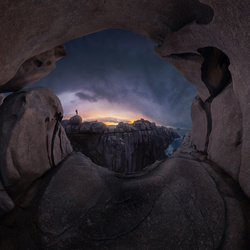This scene of our Milky Way galaxy and the Teton Mountains was captured the night of the 2017 total solar eclipse at Table Mountain sitting at 11,111 feet and two miles from the peaks. To get here, I had to hike up over 4000 feet and 5 miles in with a pack containing two Nikon D750, 35mm + 50mm 1.4 Sigma Art primes, a headless carbon tripod, and an 8 pound brick named Gigapan.
I split the hike into three days due to the pack overloaded even further with a tent, sleeping bag + pad, a heavy bear canister to fend off those pesky grizzly bears, a bunch of food and other supplies like headlamps, water filtration, and batteries. The hiking up was mid 90F but I almost froze to death that sleepless night while wearing fall clothing in the face of cutting glacier winds coming off the Tetons and valley very far below.
As the Earth rotated the galaxy into alignment over the peaks, I mounted the Gigapan atop my tripod and input the scene's upper-left starting point, lower-right ending point, the camera's 50mm focal length and desired % overlap. The Gigapan calculated the angles and triggered the camera 125 times, each an 8-second, F/2, ISO 3200 exposure followed by a second run using a closer focus point and exposure adjustment to get the foreground. The tent, set up earlier in the day, was too far back over treacherous rock so I did jumping jacks and ran in place for many hours until the sun rose behind the mountains.
Back in editing, after purchasing new down outerwear, I combined the shots into a very large image and unwarped the spherical capture into a 1024 megapixel rectilinear view causing the galaxy to arch between two pots of gold on the horizon, Jackson Lake and Jackson Hole. The large cluster below the Milky Way and above the layer of green air glow is our nearby Andromeda Galaxy.





Nice!
great Shot!!!
Stunning
Exquisite!!
Stunning work! Truly next level!
I love this and I want to give it a 5 star but to me, the majority of stars look like noise or grain. I could be wrong but it appears as such, but this took skill, aptience, and likely great physical effort, unless if you turn around and there is a Gondola or a parking lot. To hike to a spot like that, wait for the darkest light, lugging around camera gear and then a return most likely in dark or perhaps you camped or hiked out in the dark, nonetheless the effort to capture a prize like this should never be understated, unless again there's a parking lot behind you. Great shot
I can clear up your questions:
1- noise was pretty low. The D750 is a clean camera even at ISO3200. The F/1.4 lens was great at capturing alot of signal. All of the points of light you see are real stars and galaxies.
2- My description also states that I hiked in over 5 miles and up about 4000 feet. Didn't include that my pack weighed 70 pounds at the start.
3- no gondola, no parking lot nearby
4- In description, I state that I stayed up all night, saw the sunrise from my position, then hiked back down to car many miles away in the morning light.